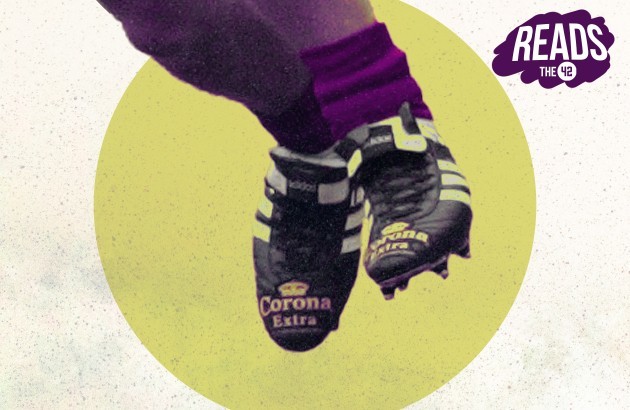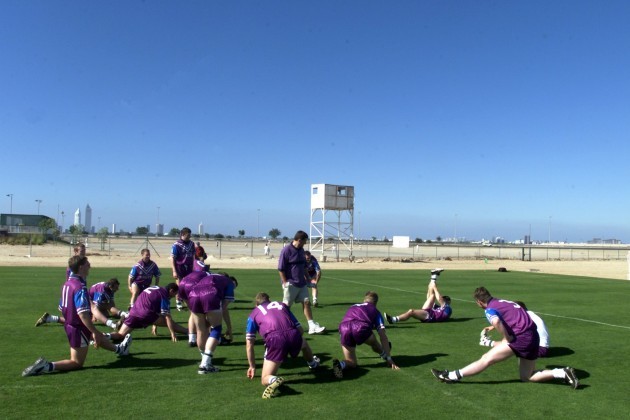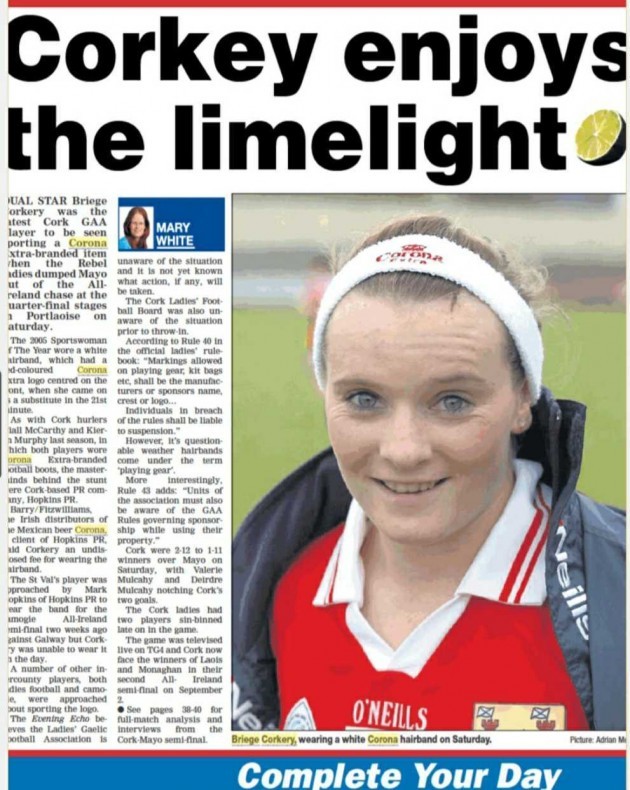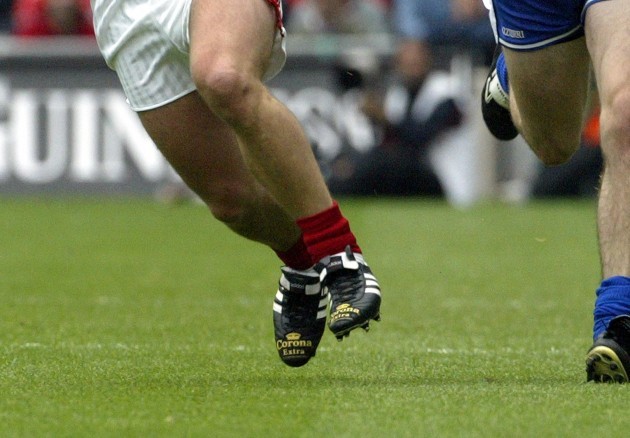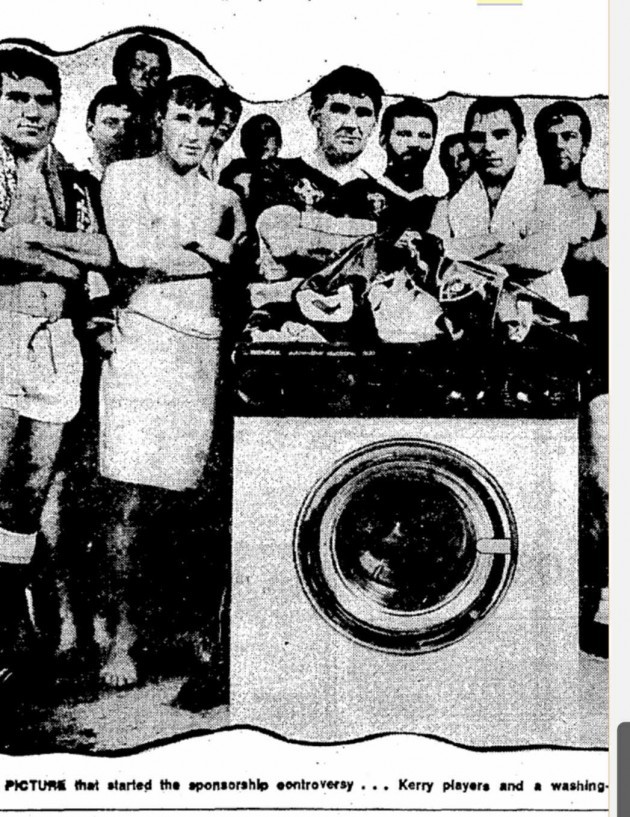WHEN THE KERRY footballers approached the county board about a fundraising project to pay for a team holiday in 1981, they were told to proceed with their efforts but that they would be doing so alone.
Mick Spillane, who made his debut for the Kingdom in the 1978 All-Ireland final, recalls a ballpark figure of £50,000 to pay for the trip. You can refer to your euro converter for an equivalent in today’s cash value.
The county board, Spillane says, didn’t think they would reach that target.
Such volumes of money being associated with an amateur sports team was unheard of at the time. Team holidays were an even rarer critter.
The idea belonged to then manager Mick O’Dwyer, who realised that rewards of this magnitude would motivate the players to keep winning All-Irelands. Under O’Dwyer’s stewardship, they had already lifted the Sam Maguire four times since 1975 and there were more walks up the Hogan steps on the horizon.
“We subsequently went off and raised £100,000, so we raised way more than what they thought,” Spillane tells The42 about the outcome of their fundraiser which paid for a five-week holiday to Australia. It was more like a world tour that had stop-offs Down Under as well as in New York, San Francisco and Hawaii.
Again, it’s a rough estimate in terms of the money raised, but that’s small potatoes when you’re talking six figures.
“It’s the fact that we took control ourselves,” Spillane adds. “We were taking on the GAA as such and the GAA was not in control. Now they are.”
This was a Kerry team who had a sense of their commercial worth, and they were eager to explore it. They defied controversy by engaging in sponsorship deals with Adidas, and posed for topless photos as part of an iconic arrangement with the Bendix Washing machine company.
As Spillane infers, they provided the blueprint on how to market themselves and earn rewards for their players.
Below is a selection of accounts that illustrates the GAA’s transition into that world; the stories of success, of blunders, of exploitation and of sponsorship deals that seem unfathomable today.
- For more great storytelling and analysis from our award-winning journalists, join the club at The42 Membership today. Click here to find out more >
Cigarettes and All-Stars
It wouldn’t sit well in our modern code of ethics, perhaps, but in the 1970s, the GAA All-Stars were sponsored by a tobacco company.
Retired GAA correspondent for the Irish Examiner, Jim O’Sullivan, was there for all seven years of PJ Carroll and Company’s association with the GAA’s annual awards between 1971 and 1978.
There were also international tours for the players who were honoured each year.
O’Sullivan recalls how Carroll’s became chosen as the inaugural sponsor on the back of its association with an All-Ireland seven-a-side competition that wasn’t part of the GAA’s official structure.
“A group of journalists and sponsors floated the idea of Carroll’s extending their sponsorship on a grander scale,” O’Sullivan begins, while also emphasising the role of Mick Dunne — father of RTÉ news anchor, Eileen — in bringing the concept to life.
“They put it to Pat Heneghan [Carroll's representative] and he immediately showed a keen interest. He brought Gaelic games to Carroll’s which was surprising at the time.
“There was a fear that the GAA would not support the idea because it was a cigarette company. They’d be in contact with the [GAA] Director General Seán Ó Síocháin, and he showed great interest.”
The All-Stars ceremony was held as a virtual event in 2020 due to the pandemic, but in ordinary times, it’s a glamorous red carpet occasion. It was much the same in the ’70s, with the first tour abroad taking place in 1972.
O’Sullivan was part of the travelling party who stayed with families once they arrived.
“For players to be taken to America was a big thing back then,” he says looking back. “Not that many players had the opportunity to travel abroad, especially to America. The early years of the tours were concentrated in San Francisco which was a huge milestone for players.
“In time, the tours were extended and they went to Singapore, Argentina, Buenos Aires. It was extraordinary. I suppose the big thing in America was the link with the Irish population in the States. The time of the first tour, they took in New York and they were once or twice in Boston.”
O’Sullivan doesn’t recall much opposition to the idea of a cigarette company forming links with the GAA, but attitudes appeared to shift as the years went by.
In 1976, the Irish Press published an article carrying the headline “GAA chief hits back in cigarette ads row.” In it, Ó Síocháin responded to comments made by founder and president of the Irish Heart Foundation, Dr Risteard Mulcahy, who criticised the association over its relationship with Carroll’s.
Irish people were starting to learn about the dangers of smoking, according to O’Sullivan, and the end for O’Carroll’s sponsorship of the All-Stars arrived in 1978.
Charlie Haughey, who was the Minister for Health at the time, brought in a law which gave him the power to ban or control all advertising and sponsorship by cigarette companies.
This law carried fines of up to £10,000 with additional fines for repeated offences.
“Advance speculation,” one report in the Evening Herald reads, “of the Tobacco Products bill suggested that it was not intended to affect the sponsorship of existing events like the Carroll’s GAA All Stars.
“However, there is absolutely nothing in the legislation to substantiate that.”
Carroll’s stepped away as sponsors of the All-Stars that year and were replaced by Bank of Ireland.
The prestige of the All-Stars still stands after 50 years of honouring the top players in the GAA, and O’Sullivan says that having a consistent sponsor has been key to its success.
“I suppose as long as you had sponsors. Players [subsequently] chose the All-Stars and that was a huge change.
“The main part of the sponsorship was linked to the actual banquet on the night. The players stayed in private homes and that was grand. When the bank took over as sponsors, they put players up in hotels and that was a huge change.”
Corona and Limelight
Briege Corkery didn’t think wearing a headband with Corona Extra branding on it would cause this much fuss. The 18-time All-Ireland winner, along with other team-mates on the Cork camogie and Ladies football teams, were asked if they would partake and Corkery couldn’t see any harm in agreeing to it.
It was her own personal headgear. No rules were being violated. That’s what she was told.
She ran out for her football side’s All-Ireland quarter-final against Mayo in 2006 with the Corona bandana wrapped around her forehead. A photographer asked if she would pose for a snap. Again, she agreed, innocently believing that nothing would come of this PR move.
“There was supposed to be five or six of us doing it if not more, and I’m the only ludder who ended up doing it,” she laughs, looking back on the whole episode that brought some unwanted attention for her.
“There was a couple of different things. They had asked us to do it for the camogie and then they changed their minds. And there were a few of us in the football that were supposed to do it and some of the girls backed out. I kind of just did it and look, the thing about it [was] they told me was ‘it’s a headband, nothing can be done to you.’
“So I was like, ‘oh sure grand.’ When I look back on it, I wasn’t even starting that day against Mayo. I suppose I was probably young and naive and probably a little more carefree and I probably just chanced it.”
For a more professional view on player endorsements in the GAA, Teneo’s CEO, Mick O’Keeffe offers some interesting insights on the subject.
The whole concept, he says, goes back thousands of years to the time of gladiators in the Colosseum. Within the GAA, it started out as quite a local venture. Business people with an affection for the GAA who want to offer some sponsorship for their team.
We can still see that today. Social media feeds often contain pictures of high profile players standing beside a brand new car while shaking the hand of the local car dealer.
“It was very unsophisticated,” O’Keeffe explains. “It tended to be personal relationships, it tended to be the week after the All-Ireland, a guy starring in a TV ad.
“Not very strategic and I would say a little bit Wild West in that the players were probably unprotected and they didn’t really know what they should have been doing in terms of their value, and the brands were probably a bit opportunistic, albeit probably well-meaning.
“This inference that early on, probably a lot of players were undersold and I hate that terminology. They probably did stuff not really knowing if they should be charging more because it’s a TV ad or a print ad.
“Bookies tended to be very opportunistic with players. And then we found that a lot of agencies were using players in sort of a guerrilla way and I think this kind of marketing activity became very much in vogue where brands tended to be very opportunistic and cannabalise events and stuff like that.”
This all resonates with Corkery’s story. As she recalls, “it blew up in my face a small bit”. An article about her headband appeared in the Evening Echo by Mary White, author of the brilliant book, ‘Relentless’.
White wrote at the time that an Irish distributor of Corona, and a client of a Cork-based PR firm, paid Corkery a fee to wear the hairband. There was a possibility that a rule had been broken with regards to labels on playing gear.
Former LGFA PRO Fr Liam Kelleher also spoke critically about the incident in the Irish Examiner, and claimed that Corkery had been exploited.
“The Ladies Football were threatening to suspend me for a bit and that’s when the shit hit the fan I suppose,” Corkery remembers.
“It made papers that they didn’t think it would make. I look back on it cringing.
“I think Mary Collins rang to say, ‘Briege, you’re in trouble here, you could be suspended.’ And this was coming into an All-Ireland final. So maybe that year I created a bit of hassle alright for the management.
“Nobody needs that rubbish coming into an All-Ireland final. I was worried for myself that I was going to end up being a disgrace.
“So I rang the [LGFA] president straight away because I didn’t think it was going to come to that.
“I’m sure the girls were like, ‘Briege you absolute numpty.’ But look, I spoke to her [the president] and said that I was promised that nothing was going to come of this, that it was my own headgear and if I thought it was giving out the wrong thing, I wouldn’t have done it.
“Thankfully she was happy enough.”
There were other incidents of endorsement deals that exposed players to bad press. The year before, Cork hurlers Niall McCarthy and Kieran Murphy encountered controversy when they wore a Corona logo on their playing boots.
In 2003, Wexford duo Paul Codd and Damien Fitzhenry along with Cork’s Seán Óg Ó hAilpín escaped suspension after carrying hurleys that brandished the Paddy Power label.
O’Keeffe explains how the GAA and its players have become more knowledgeable about engaging with player endorsement deals in a more productive and conscientious way.
“I think people make mistakes and it would be hard to sanction a young person around it. But you have to look at it from the association’s perspective where they’re trying to sell sponsorships and rights, and maybe charging someone €200,000 to be the sponsor of the competition.
“And then someone comes along a piece of clothing and they dominate the headlines the next day.
“The sports associations have become far more clear on what’s allowed and what’s not allowed.”
Do You Still Have Your Bendix?
The Kerry footballers were pushing the envelope in the 1980s. It began with an adidas deal in ’81 which they struck as part of their funding efforts for the Australian tour. It left them butting heads with the GAA.
In his autobiography, ‘Blessed and Obsessed,’ O’Dwyer writes that he promised the German sportswear company that his players would wear their gear “even if it wasn’t allowed under archaic GAA rules”. Kerry received £10,000 as part of the deal, which was a huge boost for their Australia trip. But conflict ensued with the GAA.
History records inquiries, probes and meetings about Kerry’s sponsorship conduct.
For the 1981 All-Ireland final against Offaly, Kerry wore a strip with the adidas logo on it. The GAA rulebook at the time stated that “all playing gear shall be of Irish manufacture.” A report in the Evening Herald from that time reads that the Kingdom believed there was no violation on their part as the gear they wore was manufactured in Donegal.
“The adidas thing had been brewing for a little while before that,” Mick Spillane explains.
“Cork wore adidas jerseys in about 1976 or 1977 in a Munster final and there was hell to pay. So adidas were clipping at the heels for a while.
“It was the fact that the adidas stuff we were wearing wasn’t made in Ireland. And then I do remember we had tracksuits and all that and we had to had to plaster the adidas sign before we went out.
“It took them a long time to get around that rule that the stuff was made in Ireland and I suppose the whole motivation was money really. We were very much a core unit in that there wasn’t a big change in personnel down through the years.
“O’Dwyer kept looking for ways to keep guys motivated and the way he did it was trips. He looked upon any bit of money we raised went to the lads and we started off team holidays.”
Another sponsorship row erupted between the GAA and the Kingdom in 1985. On the morning of the All-Ireland final against Dublin, an advertisement appeared in the newspapers which was captioned: ‘Only Bendix Could Whitewash this lot.’
It was a photo of some of the Kerry players standing topless alongside O’Dwyer with a Bendix Washing machine. Spillane, who was based in Dublin, didn’t feature in the picture that was taken after one of Kerry’s training sessions.
His brothers kept him abreast of the comings and goings down south. When he eventually saw the photo, he could only laugh at the image and marvel the genius behind it.
“There were a load of pictures taken, there was the one that appeared on the Sunday and then they had two options for the Monday whether we won or lost.
“The Sunday one said ‘Only Bendix could whitewash these.’ The Monday one said, ‘Only the Bendix team could ever beat these guys.’
“I remember seeing the photos and thinking it was hilarious. The newspapers used to come out at nine o’clock on a Saturday night and that was the first time I saw it.
“Down through the years you’d get the jibes, ‘I presume you’re still using the Bendix,’ but no-one ever saw a washing machine.”
The bold advertisement ploy stoked the fire and the GAA hierarchy began reaching for the rulebook again.
O’Keeffe outlines how the association was trying to process what would have been considered quite a provocative image at the time.
“The Bendix one is quite interesting in that I think it just raised eyebrows, GAA players with their tops off and their shorts and it’s a bit edgy for where the GAA was at back then.
“You’re coming out of 1970s Ireland and into the 80s and that was probably one where people thought, ‘Oh my God.’ The GAA would have been conservative with the demographic so there was probably a little bit of the fear of the unknown.
“In fairness to the GAA, people will talk and talk before eventually coming around to the right conclusion.”
The flare-ups of controversy didn’t bother Spillane. He had the prize of a team holiday to keep him motivated and the all important on-field matters to keep him focused.
The team holiday is a far more common sight now in the GAA. For All-Ireland winners, the trip abroad punctuates their year and brings everything to a close before facing into the next season.
O’Dwyer’s vision kickstarted it all. Sponsorship and player endorsement deals have certainly evolved in the GAA, although the contentious element continues to lurk in some cases.
The recent announcement of Cork GAA’s sponsorship arrangement with Sports Direct was seen as divisive over Mike Ashley’s ownership of Newcastle United and the working conditions for staff of Sports Direct staff.
“Some of the sports are only catching up,” says O’Keeffe.
“Gaelic games took time to catch up with some of the professional sports as well but I think now that people are critical that it’s a bit sanitised, but at least the money is going into the association and being filtered back out.
“And if players turn up to something, they’re well briefed, they’re well paid for their time and rightfully so. Brands have got better at looking at players more sophisticated, looking at the player, are they the right fit, a bit of background, are the kind of person we want to be involved with? Are we the right company for them to be involved with?
“If a player is educated and knows what the campaign [is about], you’ll get a lot more out of them.”
For more great storytelling and analysis from our award-winning journalists, join the club at The42 Membership today. Click here to find out more >

